History
The Grizzly and Wolf Discovery Center was started by Lewis S. Robinson, and opened in 1993 with three bears as the Grizzly Discovery Center. It was intended as a sanctuary for bears that were removed from the wild because they had become too familiar or aggressive with people. In 1995, the G.D.C was sold to New York-based Ogden Entertainment. A wolf exhibit and ten captive-born wolves were added to the center in 1996. [1]
In 1999, Ogden Entertainment decided to close the center if a buyer could not be found. Three long-term managers of the center formed a non-profit 501(c)(3) corporation and made a $1.7 million offer to include the center and undeveloped land north and south of the center. The offer was accepted, and was financed by a 30-year financing package guaranteed by a United States Department of Agriculture program for rural development. [1]
The center then made agreements with Yellowstone National Park to host some of the park's programs and to test bear resistant containers for the United States Forest Service. In 2001 it received accreditation from the AZA. [1]
In 2002, the center was renamed "Grizzly & Wolf Discovery Center," and purchased two buildings north of the center in order to house the "BEARS: Imagination & Reality" exhibit. [1]
Exhibits
- Bears
The bears at the center were all acquired after having become nuisance bears or the orphaned cubs of nuisance bears. They are provided with a large naturalistic outdoor habitat that includes a pool and waterfall, as well as private indoor areas. Bears are rotated into the habitat so that different combinations of bears can interact. Staff hides food in the habitat, and stocks the pond with fish, so that the bears can discover and catch food as they would in the wild. [5]
- Bears, Imagination and Reality
This exhibit was originally created by the Science Museum of Minnesota, and is now permanently located at the Grizzly & Wolf Discovery Center after having traveled around the United States. It is an interactive exhibit comparing bears in myth, art, literature, and folklore with the bear known by outdoorsmen and researchers. It contains over 25 taxidermic mounts of grizzly bears and black bears. [6]
- Wolves
The center has two packs of wolves. Two other habitats are separated by the Naturalist cabin, and two packs can see each other through the large windows of the cabin. In 2013 the Grizzly and Wolf Discovery Center added a third wolf habitat and a behind the scene wolf exhibit in 2018. In 2021 they connected the wolf exhibit they constructed in 2013 to another wolf yard, thereby extending the enclosure. In May 2019, three wolf pups (two males and one female) arrived at the center. The female was named Shasta and the two males were named Obsidian and Bridger. This pack is called the Hoodoo Pack. In September 2019, two older wolves arrived at the center, a female named Sura and a male named Lakota. This pack has been named the Fossil Butte Pack. In the spring of 2020, Sura gave birth to four pups, two males and two females. These pups will stay at the center and were the first wolves that were ever born at the center. In June 2020, the pups were named Harlequin, Meriwether, Boulder and Colter. In December 2020, Lakota passed away. (Source) [7]
- Naturalist Cabin
The Naturalist Cabin, located between the center's two wolf habitats, lets visitors see two separate wolf packs from the same indoor location through large floor to ceiling windows facing each of the packs. The cabin also includes interpretive displays and a National Geographic film on wolves, and provides a place for the daily "Pack Chat." [8]
Ground squirrel Exhibit
In 2015, the Grizzly and Wolf Discovery Center added a unit of Ground Squirrel Exhibit that allows guests a deeper appreciation of predator and prey relationships. Unlike the center's bears, the Ground Squirrels are allowed to go through their natural hibernation. They emerge in March and go back into hibernation in August. (Source) [7]
Bird Of Prey Exhibits
In 2013, the Grizzly and Wolf Discovery Center added four new bird of prey exhibits that house raptors that can no longer survive in the wild. In 2014 the center added an additional bird of prey exhibit and renovated the former golden eagle aviary into a new home for their bald eagles. The exhibit is open from April to November. (Source) [7]
Warming hut
in 2016 the Grizzly and Wolf Discovery Center built a new viewing area for the bears called the Warming Hut. This new viewing area allows guests to view the bears while staying warm as well. (Source) [7]
Other attractions
In 2014, the Grizzly and Wolf Discovery Center built a new exhibit called Bears on Easy Street. It is an exhibit that teaches people how to be bear aware and also ways to keep bears away from their house. In 2013, the Grizzly and Wolf Discovery Center opened a new kitchen behind the scenes, as well as a new playground area for children. A new outdoor amphitheater was added in 2014. (Source) [7]
‘’’Banks of the Yellowstone’’’ In 2019, the center opened its new Banks of the Yellowstone Exhibit. This new exhibit complex features large freshwater aquariums for North American river otters, Cutthroat Trout, Arctic Grayling, Tiger salamanders Columbia spotted frog, Rubber Boa And Garter Snake. The center also expanded the River Valley wolf habitat and connected the exhibit to the riparian building. (Source) [7]

The coyote, also known as the American jackal, prairie wolf, or brush wolf is a species of canine native to North America. It is smaller than its close relative, the gray wolf, and slightly smaller than the closely related eastern wolf and red wolf. It fills much of the same ecological niche as the golden jackal does in Eurasia; however, the coyote is generally larger.

Connecticut's Beardsley Zoo, located in Bridgeport, Connecticut, is the only Association of Zoos and Aquariums (AZA)–accredited zoo in the state of Connecticut. The zoo includes one of the few carousels in the state. The zoo has around 500 animals, from over 100 species, and welcomes about 280,000 visitors a year.

The Oakland Zoo is a zoo located in the Grass Valley neighborhood of Oakland, California, United States. Established on June 6, 1922, it is managed by the Conservation Society of California, a 501(c)(3) non-profit organization dedicated to the conservation of wildlife both locally and globally. The zoo is home to more than 850 native and exotic animals and is a member of the Association of Zoos and Aquariums (AZA).

The Cheyenne Mountain Zoo is a zoological park located southwest of downtown Colorado Springs, Colorado, on Cheyenne Mountain in the United States. At an elevation of 6,714 feet (2,046 m) above sea level, it is the highest zoo in the country. The zoo covers 140 acres (57 ha), 40 of which are in use. The zoo houses more than 750 animals, representing nearly 170 different species, with more than 30 endangered species. The zoo was ranked the #4 best zoo in North America in 2018 by USA Today. It is accredited by the Association of Zoos and Aquariums.

The Cleveland Metroparks Zoo is a 183-acre (74 ha) zoo in Cleveland, Ohio. The Zoo is divided into several areas: Australian Adventure; African Savanna; Northern Wilderness Trek, The Primate, Cat & Aquatics Building, Waterfowl Lake, The RainForest, Asian Highlands, and the newly added Susie's Bear Hollow. Cleveland Metroparks Zoo has one of the largest collections of primates in North America, The Zoo is a part of the Cleveland Metroparks system.

The Mesker Park Zoo and Botanic Garden is a zoo that opened in 1928 in Evansville, Indiana, United States. It is located in Mesker Park on Evansville's northwest side and is run by the City of Evansville.

The Abilene Zoo is a 16-acre (6.5 ha) zoo located in Abilene, Texas. The zoo has over 800 animals representing over 175 species. Attendance for 2021 was 255,000.

Stone Zoo is a medium- to small-sized zoo of about 26 acres (11 ha) in Stoneham, Massachusetts, United States. Founded in 1905, the zoo includes low-lying areas densely developed with smaller exhibits for animals as well as rocky forested hillsides devoted to larger habitats for Species Survival Plan programs. It is operated by the Commonwealth Zoological Corporation, doing business as Zoo New England, which also operates the Franklin Park Zoo in Boston.

The Dakota Zoo is a zoo in Bismarck, North Dakota located on the banks of the Missouri River. It is the third zoo built in North Dakota. The Dakota Zoo is accredited by the Association of Zoos and Aquariums (AZA).
ZooMontana is a 70-acre (28 ha) zoo located in Billings, Montana, U.S. and is Montana's only zoo and botanical park. The zoo currently maintains nearly 100 animals, representing 58 species. These animals all live in habitats designed to imitate their natural habitats. The zoo was incorporated and established as a nonprofit 501(c)(3) organization in 1992. It focuses on year-round wildlife native to Montana, the Rocky Mountains, and other cold temperature regions at or above the 45th parallel. Indoor habitats include animals from around the world. The zoo hosts over 160,000 visitors per year.
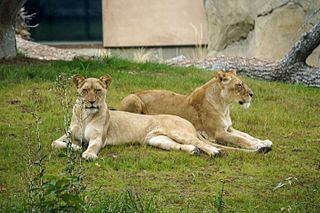
The Fresno Chaffee Zoo is a zoo in Roeding Park in Fresno, California covering 39 acres and housing over 190 species. Its attractions include Stingray Bay, Dino Dig, Valley Farm, Sea Lion Cove, African Adventure, and Ross Laird's Winged Wonders Bird Show. The zoo is accredited by the Association of Zoos and Aquariums (AZA) and is a member of the World Association of Zoos and Aquariums (WAZA).

Denver Zoo is an 80-acre (32 ha) nonprofit zoological garden located in City Park of Denver, Colorado, United States. Founded in 1896, it is operated by the Denver Zoological Foundation and funded in part by the Scientific and Cultural Facilities District (SCFD) in addition to ticket sales and private donations. It is the most visited paid attraction in Colorado.
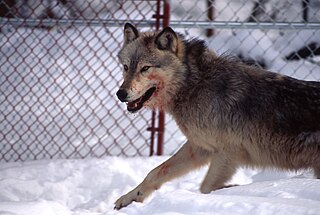
Wolf reintroduction involves the reintroduction of a portion of grey wolves in areas where native wolves have been extirpated. More than 30 subspecies of Canis lupus have been recognized, and grey wolves, as colloquially understood, comprise nondomestic/feral subspecies. Reintroduction is only considered where large tracts of suitable wilderness still exist and where certain prey species are abundant enough to support a predetermined wolf population.
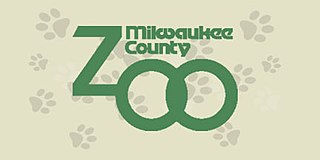
The Milwaukee County Zoo is a zoo in Milwaukee, Wisconsin, operated by the Milwaukee County Parks Commission and is accredited by the Association of Zoos and Aquariums. The zoo averages about 1.3 million visitors a year. The zoo houses 3,100 animals from 350 species and covers an area of 190 acres (77 ha). The zoo is noted for the second birth of polar bears and siamangs in captivity and for their locally famous gorilla Samson, who lived from 1950 to 1981 and whose bones are now on display at the Milwaukee Public Museum. During World War II, a celebrity animal of the zoo was Gertie the Duck and her ducklings. The zoo is also home to one of the largest group of bonobos in one location outside their native Democratic Republic of the Congo, and has two cheetahs from the National Zoo in Washington, DC.

WolfQuest is a 3D wildlife simulation video game originally developed by the Minnesota Zoo and game developer company Eduweb, and developed solely by Eduweb since 2013. The game's main purpose is to help players understand wolves and the roles they play in nature by being virtually incarnated as a gray wolf themselves. WolfQuest challenges players to learn about wolf ecology by living the life of a wild wolf in Yellowstone National Park.

Northwest Trek Wildlife Park is a 723-acre (293 ha) wildlife park located near the town of Eatonville, Washington, United States. The park is home to black and grizzly bears, grey wolves, bald eagles, a cougar, wolverines, bobcats and more. Its primary feature is a tram tour which takes visitors through a 435-acre (176 ha) free-roam area. The park also allows guests to drive their own vehicles past bison, mountain goats, Roosevelt elk, deer, caribou, swans and more on a Wild Drive tour. Guests can also take a premier Keeper Adventure Tour and go off-road in a Jeep with a keeper and up close to wildlife. The Zip Wild zipline is also open seasonally.

The ecology of the Rocky Mountains is diverse due to the effects of a variety of environmental factors. The Rocky Mountains are the major mountain range in western North America, running from the far north of British Columbia in Canada to New Mexico in the southwestern United States, climbing from the Great Plains at or below 1,800 feet (550 m) to peaks of over 14,000 feet (4,300 m). Temperature and rainfall varies greatly also and thus the Rockies are home to a mixture of habitats including the alpine, subalpine and boreal habitats of the Northern Rocky Mountains in British Columbia and Alberta, the coniferous forests of Montana and Idaho, the wetlands and prairie where the Rockies meet the plains, a different mix of conifers on the Yellowstone Plateau in Wyoming, the montane forests of Utah, and in the high Rockies of Colorado and New Mexico, and finally the alpine tundra of the highest elevations.
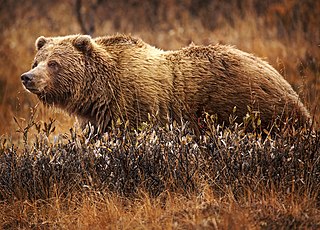
The grizzly bear, also known as the North American brown bear or simply grizzly, is a population or subspecies of the brown bear inhabiting North America.
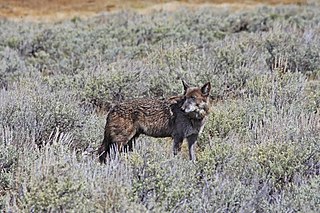
926F (Spitfire) (April 2011 – November 2018) was a wild wolf popular with visitors of Yellowstone National Park. She was killed about a mile outside the park boundary by a hunter when she crossed from the park into Montana, where the hunting of wolves was legal.



















